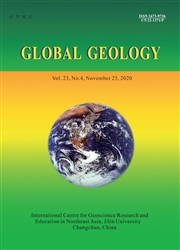Study on fluid inclusions and features of ore-forming fluids of Diakha gold deposit,Mali,West Africa
作者:Yassa Konare,WANG Keyong,WANG Zhigao
摘要:The Diakha gold deposit is located in the southeastern margin of the highly prospective/productive Paleoproterozoic(Birimian)Kédougou-Kéniéba Inlier.Gold mineralization is closely associated with a narrow,sub-vertical,NE-trending shear corridor.The corridor is to the east of a sinistrally reactivated D1 west-dipping fault,which emanated from SMSZ(D2 reverse-sinistral regional structure).The mineralization is hosted by fine-grained sandstone and breccias units associated with a moderate to strong hydrothermal alteration,which is dominated by albitization,carbonization,silicification,hematization,and chloritization.Diakha field data and laboratory analysis suggest the existence of two main stages of hydrothermal mineralization,namely stage I and stage II.[JP2]Stage I is of a breccias type of mineralization and represents the major gold bearing stage.[JP]It isassociated with hematite+calcite+ankerite/dolomite and quartz pervasive alteration,controlled by the predominantly brittle-ductile NNE to NE-shearing structures of the main deformation event D2.Stage II is represented by the second minor hydrothermal episode,showing local quartz-tourmaline and tremolite alteration which is structurally controlled by the dipping S3 cleavage formed during D3 deformation.Petrographic and microthermometric studies of fluid inclusions from quartz veins reveal the presence of early dominant carbonic CO 2-pure and aqueous-carbonic CO 2-rich(LCO 2+VCO 2±H 2O)in stage I.The exclusively aqueous H 2O+NaCl±CO 2 fluid inclusions(L-type)are observed in stage II.Interpretation shows that the ore-forming fluids originated from a homogeneous H 2O-CO 2 fluid during phase separation,with trapping temperatures of 250℃to 280℃and low salinity(<6 wt%NaCl equiv),indicating an estimated trapping pressure for the deposit between 610 to 800 bars.
发文机构:College of Earth Sciences
关键词:Kédougou-KéniébaInlierDiakhadeposithydrothermalALTERATIONAu-mineralizationfluidINCLUSIONS
分类号: P[天文地球]
- Application of isolation forest to extract multivariate anomalies from geochemical exploration data
- Zircon U-Pb geochronology and geochemistry of granite in Huoluotai area of northern Great Hinggan Range
- Geochronology and geochemistry of Baicaogou tuff in Yanji,NE China and its tectonic implications for Early Cretaceous
- Application of high-density resistivity method for assessing construction safety of Shimodong tunnel in Helong City of Jilin Province
- Computation of waves scattered by inhomogeneous velocity gradient using generalized Born approximation
- Combination of structure tensor and tilt angle in the edge detection of potential field data
- Method for predicting cuttings transport using artificial neural networks in foam drilling
- Logging interpretation method for reservoirs with complex pore structure in Mesozoic-Cenozoic faulted basin around Daqing exploration area
- Structure analysis of shale and prediction of shear wave velocity based on petrophysical model and neural network
- Geochronology,geochemistry and geological significance of Early Cretaceous volcanic rocks from Niangniangshan Formation,Ningwu Basin,middle and lower reaches of the Yangtze River


